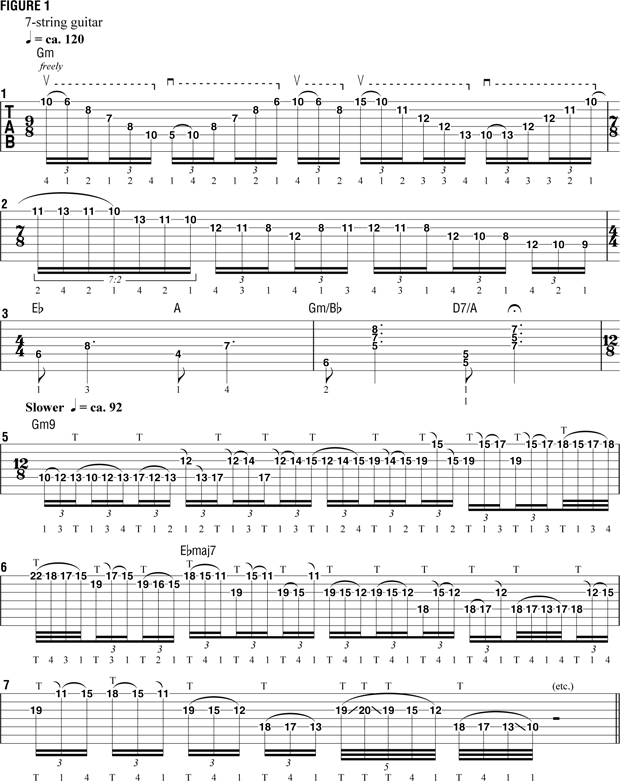Chaos Theory with Chris Broderick: Adapting Keyboard-Style Arpeggios to Fretboard Tapping, Part 1

This month’s column focuses on an original composition of mine that acknowledges the influence of classical pianists on my playing style, specifically the way in which pianists will play arpeggios across several octaves very quickly (see FIGURE 1).
In order to emulate that sound on the guitar, I’ve devised a few fretboard tapping techniques. In fact, much of my two-hand tapping technique is based on that goal and approach.
The idea is to break down the arpeggios into different sequences, such as four-note groups, and play them in a way that would be quite difficult, if not impossible, to play conventionally. This example is also cool because it has some unusual, “advanced classical” chords in it, such as a Neapolitan chord, an augmented III (three) chord, and some diminished seventh chords.
Let’s examine the first half of FIGURE 1. I start with a second-inversion G minor arpeggio (G Bb D). “Second inversion” means the arpeggio begins (and ends) on the fifth, which in this case is D (see bar 1, beats one through five). On beat six, I switch to a root-position G minor arpeggio, which means that it starts (and ends) on the G root note.
All of the phrases in bar 1 are executed with sweep picking. On beat one, I begin with a pull-off from the pinkie to the index finger, and then I reverse rake (or reverse sweep) by dragging the pick in a continuous upstroke across the top five strings through beat two. Beat three begins with a hammer-on and is followed by a forward rake (or downsweep) as the pick is dragged in a continuous downstroke across the strings. The same sweeping techniques are utilized throughout the remainder of the bar.
In bar 2, I begin with a G natural minor (G A Bb C D Eb F) legato scalar run across beats one and two, then switch to down-up alternate picking, using notes from the G harmonic minor scale (G A Bb C D Eb F#). Bar 3 features a reference to the VI (six) chord, Eb, and then the II (two major) chord, A, followed in bar 4 with a first inversion (third “in the bass,” or positioned as the lowest note in the chord voicing) Gm/Bb voicing and a second inversion (fifth in the bass) D7/A chord.
Bar 5 initiates the section of the piece wherein all of the phrases are executed with tapping, hammer-ons and pull-offs. One can analyze the rhythmic subdivisions of these phrases in a variety of ways, but the prevailing sound is that of an eighth-note triplet feel, with a 16th-note triplet played on each (or the majority of) the eighth notes. In other words, the overall feel is “ONE-trip-let, TWO-trip-let, THREE-trip-let,” etc. This triplet rhythm disguises the fact that the notes are actually phrased in four-note groups, in terms of the line’s melodic contour.
The highest note in each four-note melodic group is tapped. This results in two tapped notes per octave, which is a little different than the tapped arpeggios played later in the piece, which include only one tapped note per octave.
Beats one and two of bar 5 cover the first octave, and starting on beat three the pattern is repeated an octave higher. Once we reach the highest note in the phrase—D, first string, 22nd fret—at the beginning of bar 6, we descend through G harmonic minor on beat one and then shift to the Neapolitan chord, Ebmaj7, and descend through a series of four-note arpeggios based on the chord tones Eb G Bb D. We then ascend back through the same arpeggiated shapes. This phrase can also be analyzed as G natural minor because these notes all live within the G natural minor scale.
This is definitely a complex piece that will require a great amount of practice to get a handle on. The hardest thing of all when playing a piece like this is to keep the idle open strings from ringing. The best advice I can give is use the palm of your pick hand to mute the strings as much as possible, keeping it over the strings that aren’t being played as consistently as you can.

Get The Pick Newsletter
All the latest guitar news, interviews, lessons, reviews, deals and more, direct to your inbox!
“There are so many sounds to be discovered when you get away from using a pick”: Jared James Nichols shows you how to add “snap, crackle and pop” to your playing with banjo rolls and string snaps
Don't let chord inversions bamboozle you. It's simply the case of shuffling the notes around
